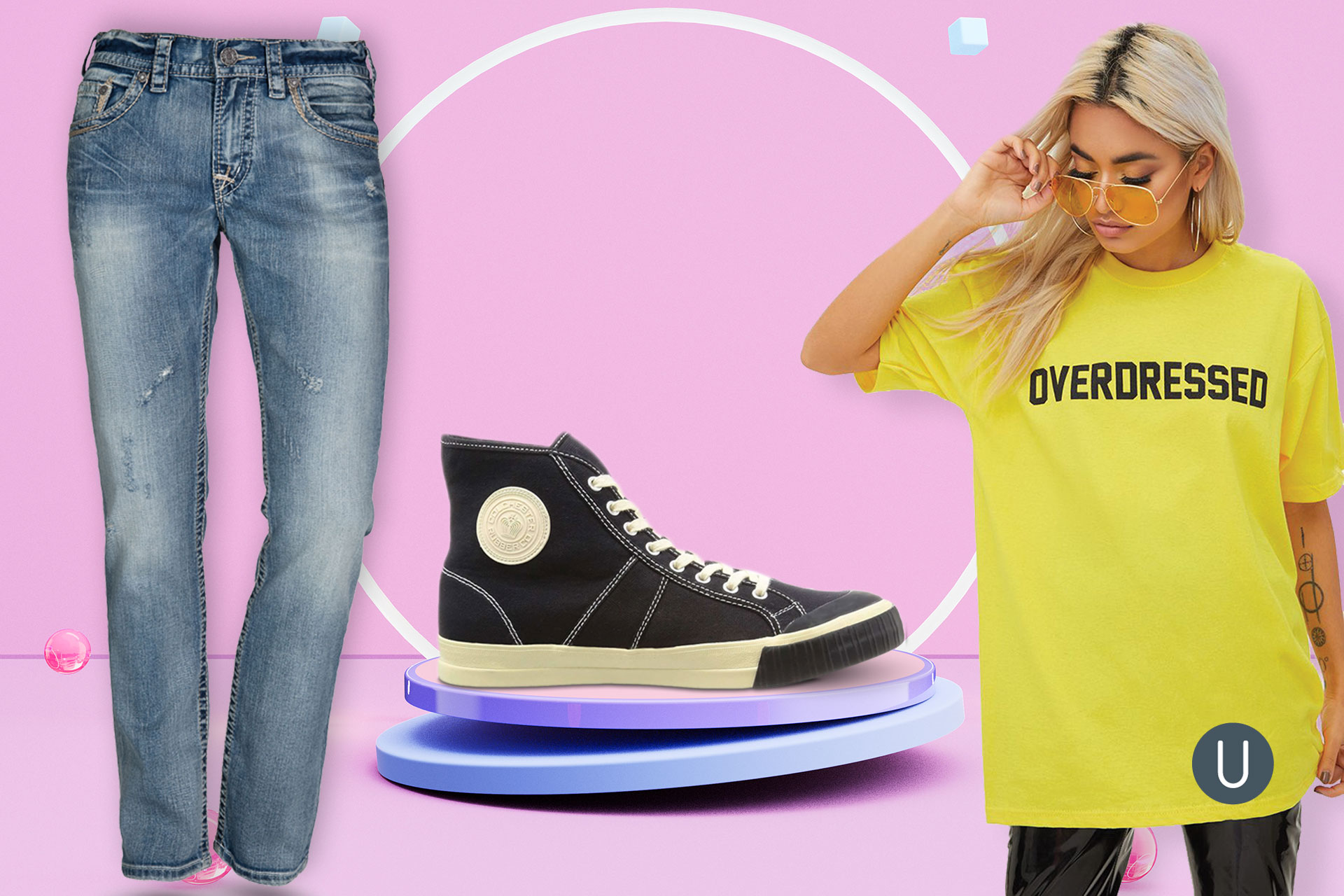Table of Contents
Casual Friday
Athleisure
A Global Uniform
Rude Behavior
Raging Against the Machine
Air Rage
Suicide Killer
Flames & Trolls
Cyberbullies
A Warning Signal for Society’s Future
After Hawaii became the 50th U.S. state on Aug. 21, 1959, the number of annual visitors to the islands steadily rose from 296,000 in 1960 to 1.7 million in 1970. The growing popularity of the islands among U.S. travelers drove a mainland boom in Hawaiian cultural artifacts, from tiki lounges to surfing to Hawaiian shirts.
What drew Royal Hawaiian Hotel management to Kahanamoku was his prominent role in popularizing an ancient Hawaiian sport, surfing, beginning in Southern California in 1912. How could one individual be so instrumental in kickstarting both surfing and a casual office dress trend? Besides his considerable surfing skills, Kahanamoku was a five-time Olympic swimming medalist, which burnished his legacy. The Hawaiian garment industry was also instrumental in the 1966 Aloha Friday rebranding, which helped.
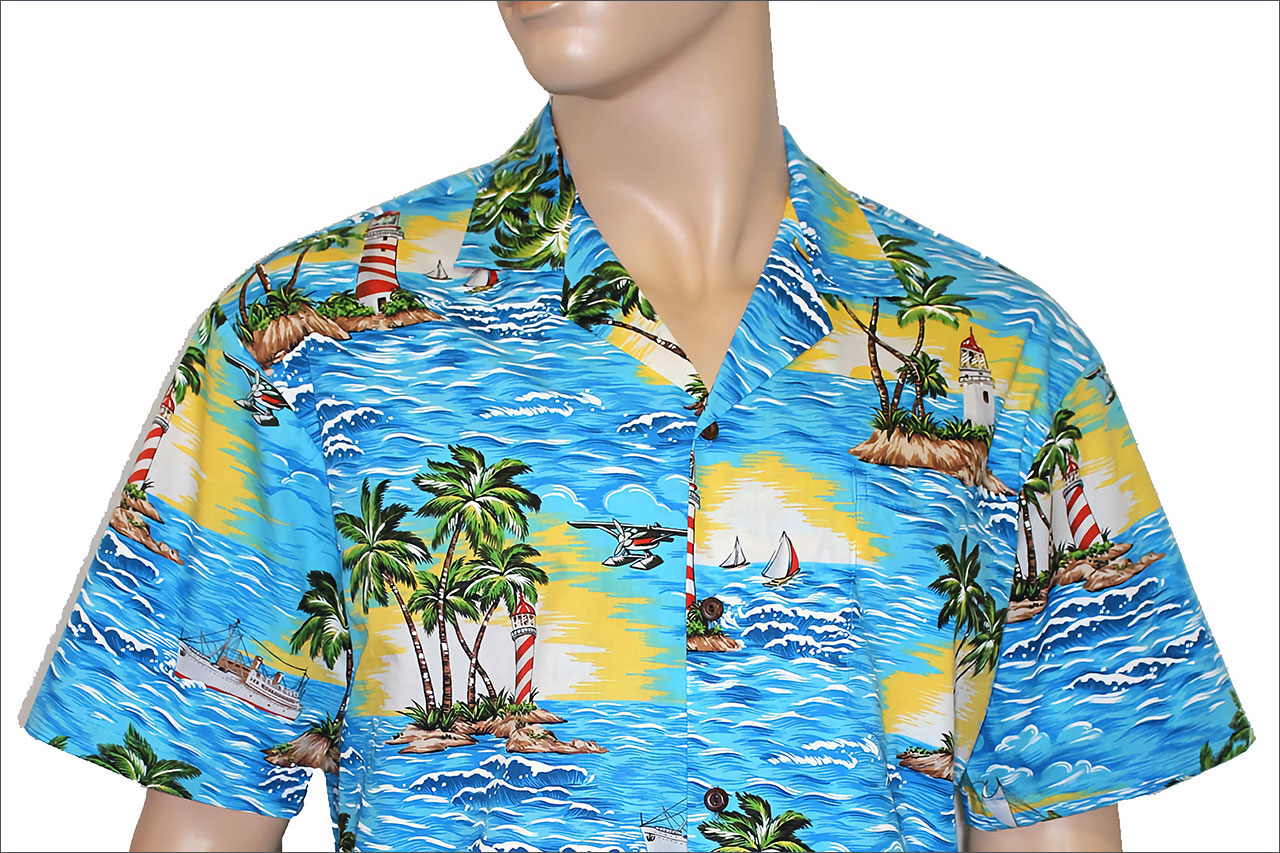
Casual Friday
By 1985, Hawaii’s tourist arrivals approached 5 million, exposing many more visitors to the islands’ more casual lifestyle. In the 1970s, Aloha Friday slowly began spreading east to California, and by the 1990s, it had made its way to New York, acquiring a new name along the way, Casual Friday.
Casual Friday gave rise to another dominant work fashion, business casual, an apparel trend that sprang from Silicon Valley’s freewheeling 1980s heydays. Thanks to brands such as Gap and Levi’s Dockers, and backed by such Silicon Valley icons as Apple, Intel and Sun Microsystems, business casual became synonymous with khaki pants and button-down plaid shirts.
In 1994, Electronic Arts Co-Founder Bing Gordon told FORTUNE, “If you don’t have anything to say, wear a suit.” To this day, “suits” remains a derogatory term used to describe staid, old-school executives living in the past. T-shirts, on the other hand, denote cool cats, usually techy types.
As the University of Nevada, Las Vegas Associate Professor of History Deirdre Clemente says, khaki pants and a button-down collar shirt became the baseline for dressing down because both garments were designed for practicality. British soldiers in mid-19th-century India wore khaki for its durability. The button-down shirt originated on England’s polo fields and was designed to prevent the collar from flapping up during a match.
Women joined the trend by ditching their pseudo-men’s suits, sweater sets, and most of their jewelry, makeup and shoulder pads, instead favoring simpler monochromatic outfits matched with more sensible shoes.
One of the earliest, non-Silicon Valley adopters of business casual was Pittsburgh-based Alcoa in 1991, Wall Street Journal fashion columnist Teri Agins writes in her book “The End of Fashion.” Alcoa employees, however, were only allowed to dress casually for two weeks after donating to the United Way. At the opposite end of the spectrum was J.P. Morgan Chase, which did not loosen its dress code until June 2016.
By 1996, nearly 75% of American businesses had introduced a Casual Friday policy, up from 37% just four years earlier. In the early aughts, electric iron maker Rowenta reported that only 12% of U.S. companies would ever consider returning to a more formal dress code.
The pandemic only served to accelerate the demise of the suit, with legions of workers confined to home, dressed in comfortable garb. Market research firm Kantar Worldpanel reports that spending on men’s suits collapsed from $587 million in 2017 to $356 million in 2021. That downtrend was also influenced by another substantial cultural change brought about by the Casual Living Ubertrend — the popularity of “activewear.”
Athleisure
Consumers are signaling that they want casual clothing that can be worn both for exercise and general use. Hip-hop and yoga initially fanned the flames of the athleisure phenomenon. Now a host of manufacturers are riding the wave of comfort with athletic style.
In the past, it was considered appropriate to dress up for travel or when going out. Now it’s commonplace to see people wearing sweatpants on planes or having dinner in what was once deemed underwear, leggings.
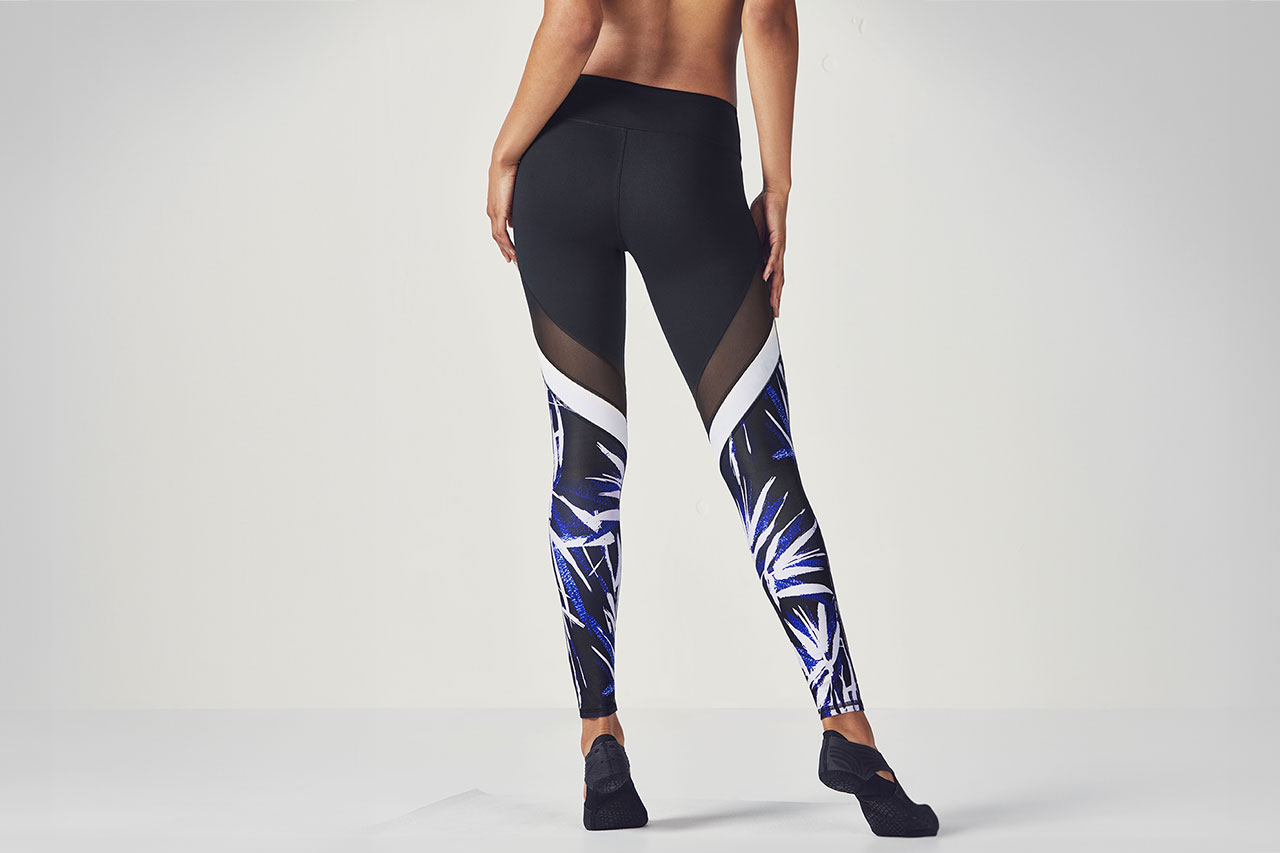
Casual Living has been a boon to athleisure apparel, a contraction of athletic and leisure, which blends comfort with function. Consumers want activewear items that can transition easily from Zumba to social settings. Athleisure is part of the global activewear market, which was valued at around $319 billion in 2022. The U.S. accounts for about 40% of the total revenue, or approximately $128 billion. In 2017, the activewear market was valued at $48 billion, which suggests the market has more than doubled in five years.
In comparison, the overall U.S. apparel market, which was also impacted by the pandemic but has recently recovered, reached $198 billion in 2021. In 2017, the apparel market was estimated at $215 billion. The disparity illustrates the growing strength of the athleisure trend, which, besides a desire for comfort and convenience among a largely overweight population, is being driven by celebrity endorsements, fitness awareness, and technological innovations in fabric and design.
The athleisure trend extends to footwear. The “sport leisure” style has become the largest category in the U.S. sneaker market, beating performance-oriented footwear. Sport leisure style sneakers are inspired by athletic activities but intended for casual and everyday use. They are not surprisingly also known as athleisure sneakers, and they include running, basketball, skate, and fashion sneakers. Sales of sport leisure style sneakers increased 17% in 2017 to $9.6 billion, the last year for which data is available.
The athleisure trend was foreseen by many science fiction movies, which often feature form-fitting “catsuits” as the apparel of choice of the future.
A Global Uniform
Have you ever thought about how the U.S. managed to bring together such diverse clothing styles from around the world? One of the most successful fashion trends that America has exported globally is the blue jean. Along with that, t-shirts and sneakers have also become a part of a universal dress code. The latest fashion trend to be embraced by people worldwide is athleisure, another North American cultural icon.
In 1853, San Francisco was in the midst of the gold rush and well on its way to becoming America’s largest city west of the Mississippi River. A Bavarian immigrant and astute merchant named Levi Strauss noticed the need for clothes that could withstand the rigors of mining. His first creation was a pair of miners’ overalls made from brown cotton tent canvas.
For the next pair, Strauss and tailor Jacob Davis decided to switch to denim, which was shorthand for serge de Nimes, a twill fabric produced in the south of France. To make the pants less susceptible to dirt, Strauss dyed the fabric an indigo blue. By the 1860s, Levi Strauss’ blue pants had become the daily wear of choice of miners, farmers and cattlemen throughout the West.
In 1873, Strauss paid $69, the price of a patent application, to buy an idea from a Russian tailor living in Reno, Nev., who had developed a technique for making miners’ pants stronger by riveting critical seams. The riveted pants were reportedly nicknamed “jeans” after the city of Genoa, where sailors wore blue cotton canvas. However, they were still referred to as “overalls” until the 1950s, when teens started calling them jeans. That led Levi’s to update its ads and packaging to reflect this change.
Over the next century, Levi Strauss’ invention would become a global sensation, an item worn by many citizens of the Western world, and even lead to a “designer jeans” market. In 2016, 143 years after the official introduction of Levi’s jeans, the Cotton Inc. Lifestyle Monitor reported that consumers now own nine denim garments on average, including six pairs of jeans.
The story is much the same for t-shirts. The U.S. Navy first used them around the 1898 Spanish American War. Today, the world buys more than 10 billion t-shirts each year. And the t-shirt market, with or without promotional messages, has become a $20 billion industry. Not too shabby for underwear.
The Casual Living Ubertrend also impacted footwear. In 1892, the Colchester Rubber Co., based in Colchester, Conn., introduced the world’s first basketball sneaker, a five-inch high-top. That same year, the United States Rubber Co., one of the original Dow Jones 12 companies, acquired Colchester Rubber. In 1916, U.S. Rubber consolidated its 30 footwear companies under one brand name, Keds. They eventually were nicknamed sneakers because they were so quiet, allowing a wearer to sneak up on someone.
As we all know, fashion directions come and go. While 64% of women surveyed two decades ago chose denim jeans as their favorite apparel item, today, consumers are moving to athleisure. Still, the global denim jeans market is predicted to generate $65 billion in sales in 2022, up from $52 billion in 2007.
Rude Behavior
“I’m sorry, Sir, but I do not believe we’ve been properly introduced” is a classic line that exemplifies British politeness. But how U.K. football fans behave nowadays has given the British a reputation for acting like drunken louts rather than being well-mannered.
Society has shed its stiff upper lip and is evolving into a culture that is far more casual and relaxed but also more unruly as courtesy and good manners become a thing of the past. A major side effect of the Casual Living Ubertrend is the evaporation of decorum.
Evidence of this undesirable phenomenon is cropping up everywhere. On Broadway, badly behaving audiences are all too common, reports the New York Post. Ringing phones, glowing screens as people text, and crinkling wrappers are par for the course in theaters these days. The situation has been exacerbated by theatergoers who can now drink alcohol during many shows, which results in fidgeting, rattling ice cups, and even patrons laughing inappropriately or nodding off and snoring.
To challenge unruly behavior, actors have been forced to respond more aggressively. In the 2015 revival of She Loves Me, a cellphone went off as Laura Benanti was singing Will He Like Me. “I’ll wait,” Benanti said. The phone continued to ring. “We’ll all wait,” she added, and the orchestra stopped playing until the phone was silenced.
Broadway is not the only one to suffer; sports fan behavior has become spectacularly bad in the past four decades. In 2011, The Bleacher Report produced a list of the worst fans in sports history, topped by a Philadelphia Phillies fan, a city with a reputation for poor behavior.
That Phillies fan, Matthew Clemmens, 21, became notorious for harassing an off-duty cop and his 16- and 11-year-old daughters when he stuck his finger in his mouth and vomited on the younger girl and her father.
The people who should know better, parents, are behaving equally poorly. In one youth basketball game, parents charged the court to throw punches at the referee. Harassment is so bad now that 70% of new referees quit within three years, according to the National Association of Sports Officials.
The trend is not limited to the U.S. In Denmark, a soccer fan ran on the field in 2007 and tried to throw a punch at the referee. Thanks to the wonders of YouTube, fans around the world can now enjoy these sordid spectacles.
The Casual Living Ubertrend is fueled, in part, by the rapid growth of the world’s urban populations, which has turned cities into faceless masses of people. Anonymity encourages offensive behavior because there is no shame involved. The fact that spectators are now actively and aggressively getting involved in public events is just the latest twist in this unsettling Ubertrend.
The role YouTube plays in legitimizing uncivilized behavior is covered in the Voyeurgasm Ubertrend.
The lack of courtesy has spilled over into politics. During a heated healthcare bill debate, Texas Republican Rep. Randy Neugebauer can be heard yelling “baby killer” while fellow Michigan Congressman Bart Stupak speaks.
These morally debatable incidences are not limited to the New World. In Italy, a fistfight broke out in 2010 in an Italian newsroom behind a seemingly clueless anchor. Fist fights among elected officials now happen regularly.
Anonymity was certainly not involved in an incident that had Faith Hill berating a fan for grabbing her husband’s private parts during a Soul2Soul 2007 tour stop at the Cajundome in Lafayette, Louisiana. The incident shows just how brazen society has become.
On Jun. 19, 2023, a fan hurled a cellphone at Bebe Rexha. Two days later, Ava Max was slapped on stage by a fan:
On July 5, it was Drake’s turn to get hit by a phone in Chicago. Twelve days later, country superstar Miranda Lambert chided a fan for taking disruptive selfies during her performance. Some stars have responded in kind. When a woman doused Cardi B with a large cup of water and ice at a daytime pool party in Las Vegas, she responded in kind by throwing her microphone in the direction of the offender:
The list of incidents is endless. Congressmen get spat on, Kanye West interrupts Taylor Swift’s VMA acceptance speech, while babies are routinely left out in 100-plus-degree car heat. The lack of sensibility and courtesy appears bottomless. Human indecency and cruelty have lost their boundaries.

Wild Plassen
In Holland, wild plassen, “wild peeing” or public urination, has caused a national outcry. One Dutch company, Urilift, has developed a creative solution that lets municipal governments rapidly deploy and neatly store away its space-age receptacles that can be lowered to the ground to hide them. San Francisco chose to install an open-air urinal to tackle the wild peeing problem to the dismay of park neighbors. The Paris version, dubbed Uritrottoir (see left), is a urinal cleverly disguised as a planter box with a capacity of 180 “pipis” — as the French like to call it.
Raging Against the Machine
In 1988, Los Angeles news station KTLA coined the term “road rage” after several shootings on the city’s freeways. According to the St. James Encyclopedia of Popular Culture, the term was inspired by “roid rage,” which refers to the sudden, violent outbursts people experience after taking steroids.
It should be stated that “aggressive driving” — including speeding, tailgating, weaving, red light running and rapid lane changes — was around long before 1988. In a 1950 Walt Disney cartoon, Motor Mania, a mild-mannered Goofy experiences a radical transformation: “Once behind the wheel, a strange phenomenon takes place. Mr. Walker [Goofy] is charged with an overwhelming sense of power, his whole personality changes, he becomes an uncontrollable monster.”
Uncontrollable monster is an apt description of what many of today’s drivers have become. Road rage received broad media coverage during the 1990s, a decade that saw the number of cars increase by 30 million, which traveled an additional 600 billion miles each year by 2000.
Besides crowded roads, anonymity is also a factor in aggressive driving. The NHTSA paints this picture of the uncontrollable monster: “Shielded from the hostile outside environment by tinted windows and a micro-climate that defies the seasons, a driver can develop a sense of anonymity and detachment.” As Villanova University Social Psychologist Erica Slotter says, “When we feel anonymous, we lose focus of our moral compass and are more likely to behave badly.” The AAA Foundation for Traffic Safety conducted a study of more than 10,000 traffic accidents linked to aggressive driving between 1990 and 1996 and found a 51% increase in serious incidents, but more frequent media reports may have influenced that jump. The number of fatal accidents involving road rage increased nearly tenfold between 2004 and 2013, rising from 26 to 247. Since 2013, road rage has been responsible for 300 deaths. But that’s a drop in the bucket compared to the 42,795 traffic fatalities in 2022, up nearly ten thousand compared to 2013’s 32,719. This is despite Americans driving less due to the pandemic.
AAA’s Prevalence of Aggressive Driving report cites that 56% of fatal crashes “involved at least one driver who was reported to have performed at least one potentially aggressive action.” Applying this barometer, the actual aggressive driving fatality number may be much higher.
The self-reported jump in aggressive driving behavior also supports that hunch. A 2002 Public Agenda study backed by The Pew Charitable Trust reported that 35% of Americans admit to aggressive driving. In AAA’s 2014 report, that figure is now 78%, with tailgating (51%) and yelling at other drivers (47%) being the leading aggressive behaviors mentioned. Although these study methodologies are certainly not comparable, anecdotal evidence suggests that road rage is becoming a bigger issue.
AAA’s July 2016 Aggressive Driving report also found that nearly two in three drivers believe that aggressive driving is a bigger problem today than three years ago. Our escalating lack of manners is such an ignominious part of the fabric of life that 79% of Americans surveyed say lack of respect and courtesy is a serious problem, according to Public Agenda.
Now contrast those opinions with the 78% who report having engaged at least once in aggressive driving in the past year, and you can readily see Goofy’s uncontrollable monster metaphor jumping to life.
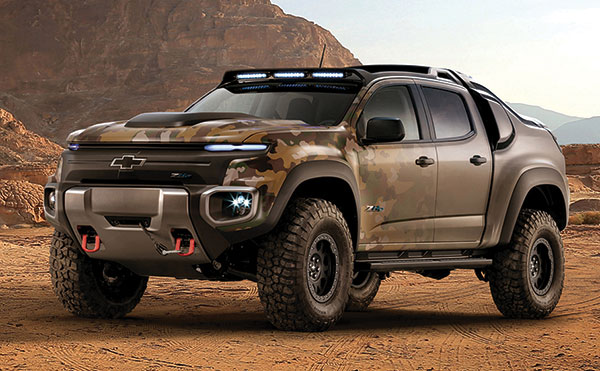
Chevrolet Colorado ZH2
Have visions of Mad Max: Fury Road dancing through your head? Preparing for a world like in The Book of Eli? Then the Chevrolet Colorado ZH2 is for you, which epitomizes the “Darth Vader” SUV trend. This threatening look, promoted by limousine companies, police, rappers, and security forces, thinks it’s cool to be safely ensconced in massive, black vehicles, capable of intimidating the public. GM calls the Colorado ZH2 “physically imposing.” Yea, right.
Air Rage
United Airlines Flight 857 was proceeding smoothly on its way to Shanghai from San Francisco. Everything was quiet in row 55, where identical twins and models Cynthia and Crystal Mikula, 22, of Buckley, Mich., were enjoying a movie and lunch. But after having too many drinks, they started calling each other profane names, got into a physical altercation and used the aircraft restroom to smoke.
Then things turned really ugly. The crew tried to restrain Cynthia, who wanted Crystal to open the aircraft’s door and got punched in the face. The pilots decided to fly to Anchorage, Alaska, 1,100 miles away, where the raging twins were arrested. As you might expect, the Apr. 19, 2001 altercation was caught on video
It was not the first U.S. air rage incident. That dubious honor belongs to Washington radio talk show host Julianne Malveaux, 42, who called a nine-year-old girl who accidentally bumped her while she was asleep “a little savage” and what The Washington Post describes as “a particularly foul four-syllable word.”
She also swore at a flight attendant who accidentally sprayed her with a can of soda while opening it and grabbed another flight attendant’s arm when asked her to put her laptop away before landing. Malveaux was arrested on arrival and charged with assault, and sentenced to probation. The Malveaux incident took place on Oct. 22, 1994.
According to the International Air Transport Association, which represents 300 airlines and 83% of global air traffic, there were 10,854 worldwide cases of unruly passengers in 2015, or one in every 1,205 flights, a 14% increase compared to the year before. In 2022, incidents jumped to one in every 568 flights, representing a doubling of cases. A footnote mentions that the “data was collated from over 20,000 reports,” providing concrete evidence that the number of cases doubled in just seven years.
The leading cause of air rage, at 23%, was alcohol or drug intoxication, followed by physical aggression in 11% of the cases. Verbal abuse and failure to follow flight crew instructions were cited in a majority of the incidents.
A horrifying example of such an incident involved Wall Street investment banker Gerald Finneran, 59, who was flying from Buenos Aires to New York on October 20, 1995. Already overserved, Finneran was harassing and assaulting flight attendants trying to get more wine. When they refused to serve him, he defecated on a service cart in first class in full view of other passengers, then began wandering around the cabin, leaving feces in his footprints and smearing some of it on the walls. This may have been one of the worst cases of air rage ever and graphically illustrates the accelerating collapse of human decency and civility.
Of course, not all air rage happens in the air. Many clashes occur right on the ground. A remarkable case of ground rage started when a gate agent welcomed passengers with a Yuletide greeting while boarding. The passenger barked at the agent, “You shouldn’t say that because not everyone celebrates Christmas.”
The agent responded, “Well, what should I say then?” He shouted, “Don’t say, ‘Merry Christmas!’” as he brushed by the agent. Once on the plane, he was greeted by a flight attendant who also wished him “Merry Christmas.” That was the last straw. He launched into a tirade that only ended after being escorted off the plane.
Casual Living has turned some into an abusive modern-day Scrooge.
Suicide Killer
Another mass shooting just took place in Jacksonville, Fla., where a sore videogame loser killed two people and injured nine. The shooter was killed in another case of revenge and suicide. The Suicide Killer trend, sometimes referred to as “going postal,” is the ultimate expression of growing disdain for human life.
David Katz, 24, of Baltimore, Md., killed two innocent people at the GLHF Game Bar in Jacksonville and permanently changed the lives of nine. He then committed his last cowardly act, taking his own life at the scene.
Going postal was first used in the 1980s to describe a violent workplace slaying at a U.S. Postal Service facility. Current or former postal employees have killed a total of 65 people in 22 workplace rage incidents between 1975 and 2017. The term surfaced on Dec. 17, 1993, in the St. Petersburg Times: “The symposium was sponsored by the U.S. Postal Service, which has seen so many outbursts that in some circles excessive stress is known as ‘going postal.’”
The worst slaying took place in Edmond, Okla. in 1986 when Patrick Sherrill, a part-time letter carrier, entered the Edmond Postal Office and fatally shot 14 employees and wounded six. He subsequently committed suicide.
Today, going postal has been subsumed by mass shootings that happen so frequently that Americans have become numb to the news. The modern mass shooting trend began in Austin, Tex. on Aug. 1, 1966, when Charles Whitman killed 16 until police shot him.
Since Sandy Hook, when the Gun Violence Archive started tracking mass shootings, 280 shootings have taken place in which a lone shooter killed four or more people. A total of 1,546 people have been killed in these shootings, 185 of whom were children and teenagers. Of those children, 20 were first-graders between six and seven years old.
In the early history of America, killing was a necessary evil. It was done to eliminate enemies, rivals and adversaries. Today’s mass shootings involve the murdering of many innocent bystanders — people who happen to be in the wrong place at the wrong time. The goal has become to eliminate as many people as possible on your way to your own grave. It’s the ultimate act of selfishness. In 2022, 48,117 people died from guns in the U.S., the second highest on record after 2021.
And yet, despite overwhelming evidence that controlling gun ownership and sales reduces murder, the U.S. government prefers to stand by and do nothing.
Flames & Trolls
Internet boosters trumpeted interactivity as its chief benefit. That two-way conversation supposedly set it apart from traditional, unidirectional media. Of course, that was before comments like the thoughtfully composed, “Ur ugly u suk and u should die,” appeared beneath a video posted on YouTube.
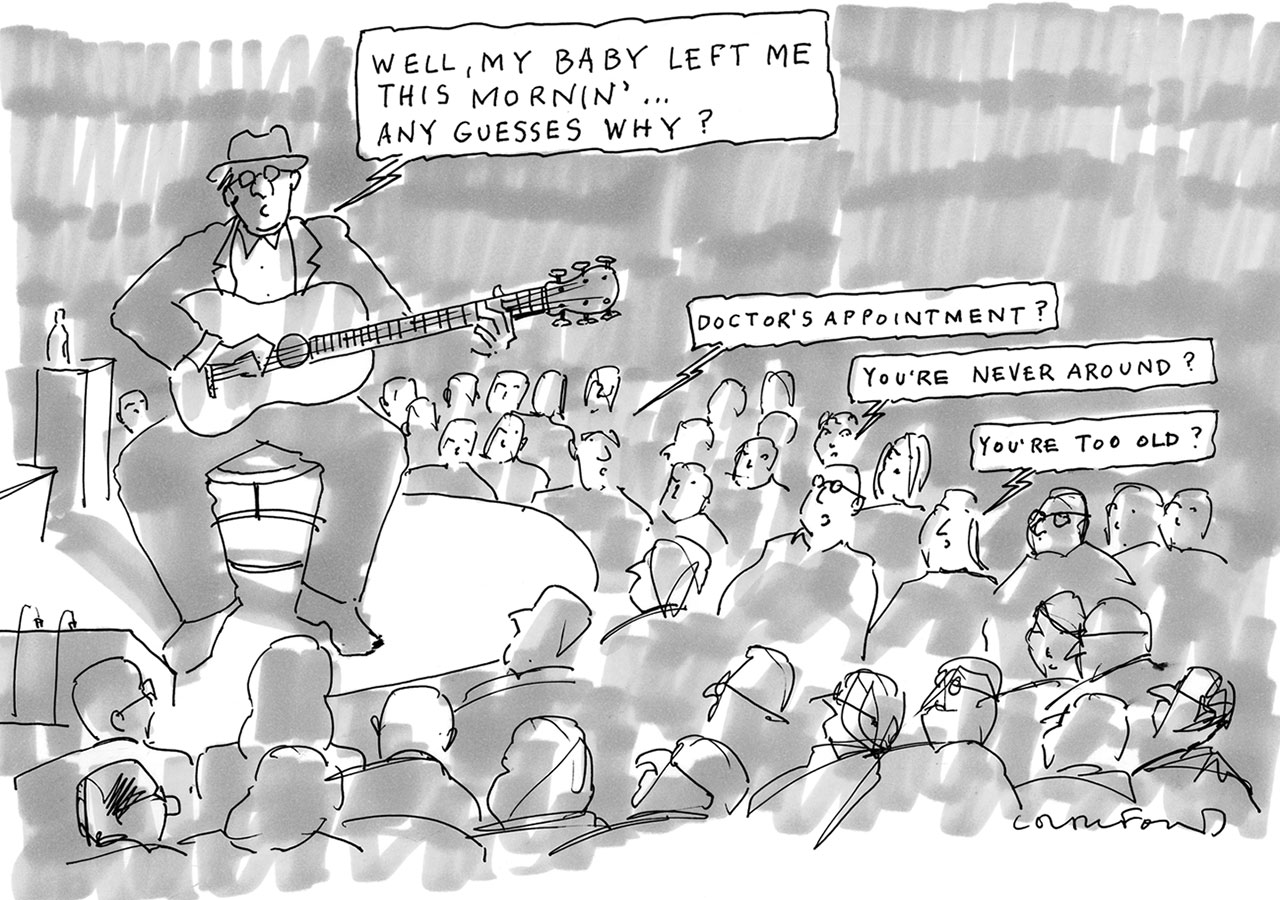
Michael Crawford’s not-so-humorous take on interactivity shows the hazards of a two-way conversation in a world dominated by the casual disregard for civility. It’s a cynical but accurate point of view on what happens when human beings are asked to engage with others these days. © Michael Crawford/The New Yorker Collection/The Cartoon Bank.
That comment was cited in a 2007 USA Today story by Janet Kornblum, who added: “Nasty comments, sometimes even death threats, have become ubiquitous on virtually any site that seeks to engage readers in discussion.” She correctly surmised that anonymity was a significant driving force behind the growing rudeness of society. Nearly two decades later, things have gotten much worse.
The decline in etiquette started in the early 1980s in internet chat rooms, where “flaming wars” and a growing incidence of “trolling” were the earliest forms of anti-social behavior. In 1983, The Hacker’s Dictionary defined flaming, derived from “inflaming,” as “to speak rabidly or incessantly on an uninteresting topic or with a patently ridiculous attitude.” Both trolling, which involves making random unsolicited and/or controversial comments designed to enrage discussion forum members, and flaming are widely practiced today in all social media. Trolls are the loudest voices in the room, the ones who write “crazy, nasty things just to get people all riled up.” Their mission is to subvert a conversation by hijacking the topic and creating a war of sorts with incendiary comments.

Pepe the Frog
Internet memes have long been a popular way of conveying a message, often humorous, but always pointed. In the dark alleyways of the internet, a once simple cartoon character, Pepe the Frog, was hijacked by nefarious forces to use as an avatar to promote hateful and offensive ideas of the alt-right. Things took such a nasty turn that the Anti-Defamation League had to add the cartoon to its online database of hate symbols. Isla Vista shooter Elliot Rodger reportedly announced his shooting in a post that used the Pepe meme. Cartoon creator Matt Furie was forced to serve cease-and-desist orders to several alt-right personalities and sites. It’s a story that makes you want to say, “People grow up.”
Cyberbullies
One afternoon in October 2006, 13-year-old Megan Meier received a message from a boy she had befriended on MySpace that read, “The world would be a better place without you.” That same afternoon, Meier, who had a history of depression and suicidal impulses, hanged herself in her bedroom.
It turned out that the “Josh Evans” MySpace account was set up by Lori Drew, the mother of Sarah Drew, who was Meier’s arch-nemesis. What parent does this? Only one who believes that cyberbullying is a cure for what ails society.
Then there is 12-year-old Gabriella Green, who was cyberstalked by two 12-year-old middle-school students. Green died from hanging on Jan. 10, 2018. Panama City Beach, Fla. police have charged the bullies.
So-called “attack videos” are also part of the psychological terror landscape. One video shows a young girl from San Mateo, Calif., being viciously attacked by a schoolmate, leading the despondent victim to abandon high school due to fear and depression.
A Warning Signal for Society’s Future
The Casual Living Ubertrend serves as an analytical lens through which we can observe numerous phenomena converging into a societal wave. This wave, rapidly permeating across all strata, poses a critical risk to the future of civilized behavior. It is a call to attention that necessitates immediate and decisive action from various pillars of our community, including government, business sectors, educational institutions, and parental figures.
The trajectory of this trend could potentially culminate in the erosion of civility and decorum unless urgent measures are implemented. Thus, it presents a challenge that we, as a collective society, must address with the utmost diligence and responsibility.
It’s the result of a mostly anonymous society where old-school values are rapidly heading toward the exit, trampling everything else on the way out. This Ubertrend is not solely responsible for the decline of civility. The trend is also being propelled by the Digital Lifestyle, Unwired and, in particular, the Voyeurgasm Ubertrends, covered elsewhere on this site.
It would take a monumental effort on the part of government, educational institutions and businesses to counter this tsunami — a distinct possibility should things worsen considerably, but highly improbable in today’s could-care-less world.
After all, many of society’s cultural leaders are also steeped in corruption and greed and show little hesitation to cheat, lie and steal. The Bernie Madoffs, Enrons and Rod Blagojeviches of the world have cast a long shadow that darkens the moral landscape.
Corporate executives cheat by sneakily charging fees that are not included in the published price. They make sure that customers can’t get easily cancel a subscription but make it very easy to sign up or upgrade. They sink their tax windfalls into stock repurchases without considering the welfare of their employees. And Wall Street condones this behavior by compensating the wrongdoers with higher share prices while punishing those who reward their underpaid workers.
Can there be a return to a more morally just society? It seems unlikely. Fully 74% of Americans believe society today is generally more ill-mannered than it was 30 years ago and that civility in politics is notably lacking. Imagine what they will say in 2050.
Expect to encounter more air- and road-rage perpetrators dressed in Hawaiian shirts and sweatpants hurling epithets at you in the very near future.

